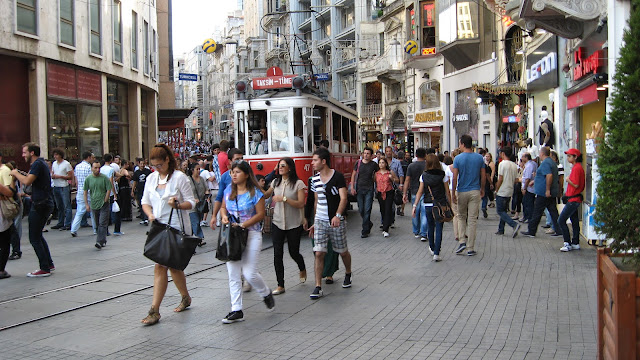Istanbul started out as Byzantium around 660 BC, then in 330 AD the name was changed to Constantinopolis - or Contantinople by Constantine the Great. The name Istanbul was adopted around 1930. It is part of both Asia and Europe divided by the Golden Horn. The geography of this area is played signifigant part in the history of this city and this country.
So to the Blue Mosque, we had walked around the area where the Blue Mosque is and Hagia Sophia sit. And were awestruck. So on our second day we had a half day tour and were taken to see the Blue Mosque, the Saint Sophia (Hagia Sofia), the Hippodrome and the Turkish and Islamic Arts Museum - a visit to a carpet place was thrown in - this became a bit of an issue but more later.
The Blue Mosque (Called Sultanahmet Camii in Turkish) is an historical mosque in Istanbul. The mosque is known as the Blue Mosque because of blue tiles surrounding the walls of interior design.Mosque was built between 1609 and 1616 years, during the rule of Ahmed I. just like many other mosques, it also comprises a tomb of the founder, a madrasa and a hospice.Besides still used as a mosque, the Sultan Ahmed Mosque has also become a popular tourist attraction in Istanbul.
Besides being tourist attraction, it's also a active mosque, so it's closed to non worshippers for a half hour or so during the five daily prayers.

We have so many pictures of the Blue Mosque. It is rich in details - beautiful doors, stained glass windows. I just could not include them all - but the last one that I will show is the entry to the courtyard. See how worn down that is - and this is marble - just imagine the feet that have crossed this threshold.
Sitting opposite the Blue Mosque across a large square is Hagia Sophia. For 900 years Hagia Sophia was the center of Orthodox Christianity until 1453 when the city became under the rule of the Ottoman empire. For the next 500 years it became a jewel of the Muslim world, the grand mosque of the sultans. In 1935, Hagia Sophia was converted into a museum of Turkish Republic by the orders of Ataturk. In 1985, Hagia Sophia was choosen a world heritage site.
The walls are covered with beautiful marble. Huge chandeliers hang from the ceiling and the dome is clad with fabulous tiles.

This part of the floor is sectioned off to protect the incredible marble inlay. And again I could add more and more pictures.
Now on to the rest of our day. We continued to the Hippodrome, but what a surprise that was - we had been walking through it, around it and in it for the last couple of days. In ancient times (203 AD) this structure was created with walls and seating for sporting events such as chariot racing. But all that is left now is the middle barrier and three obelisks - see this map held by our guide Mustafa.
 Left is the Egyptian Obelisk, below is the Walled Obelisk and below that what is left of the Sepentine Obelisk.
Left is the Egyptian Obelisk, below is the Walled Obelisk and below that what is left of the Sepentine Obelisk.
Our next stop was the Turkish and Islamic Arts Museum - this was originally built as a Palace but now is the home to beautiful examples of Islamic calligraphy, tiles and carpets. It is here we had our first cup of Turkish Coffee and parted with our tour guide and the other guests.
The tour group continued on for lunch and the rest of their tour, but we had the afternoon free to wander. We decided to take the tram and subway across the Galata Bridge to Taksim Square on the European side of Istanbul. A long pedestrian shopping street exits from the square called Istiklal Caddesi. A cute little tram runs from Taksim Square down the length of this street. The shopping features clothing, shoes, home dec and lots of boutiques. The side streets are filled with tourist shops, restaurants and small markets. "They" say that over 3 million people visit this street every single day.



















No comments:
Post a Comment